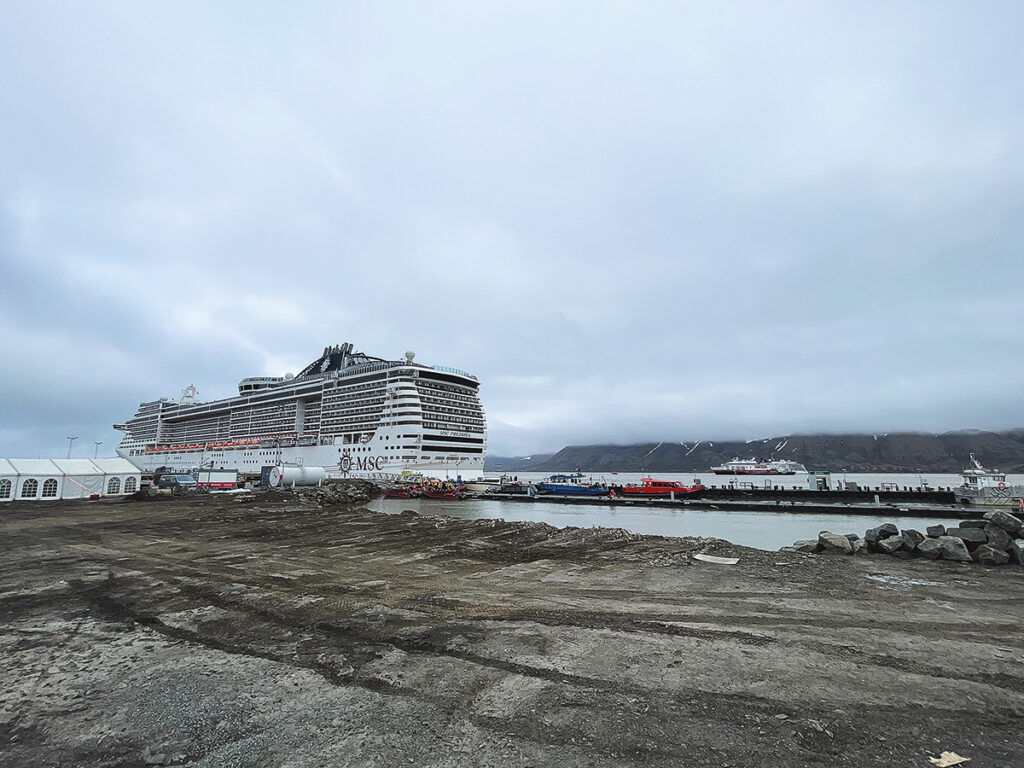© Fabienne Mannherz
Underwater noise pollution from expedition cruises
Could Arctic ports be part of the solution?
Expedition cruises to the remote Arctic are in vogue. But with their sturdy, purpose-built design, these vessels are increasing noise levels in the relatively tranquil Arctic underwater soundscape. FABIENNE MANNHERZ, MAAIKE KNOL-KAUFFMAN and HEIDI AHONEN consider whether Arctic ports could play a role in mitigating this noise.
Sound may be invisible to the human eye, but it is everything for species who live beneath the surface, helping them to communicate, navigate, forage and interact socially. This is particularly true for marine mammals.
Unfortunately, the noise patterns of ships, including cruise and expedition vessels, overlap with Arctic marine mammals’ communication and hearing ranges. The potential consequences include masking of important sounds, behavioural disturbances, physiological stress, and displacement, with cumulative long-term effects on marine population.
Unknown threats
Expedition cruise operations differ from more transitory maritime activities because the vessels spend prolonged time cruising and manoeuvring in a given area. The cruises are exploratory in spirit and seek out wilderness, so the vessels tend to venture away from established shipping routes into the comparatively secluded backyards of Arctic marine mammals. To date, there have been limited efforts to understand and address the risks that the underwater noise they bring might pose to these species. But researchers and industry pioneers are working closely to study and address these unknown threats.
It is sometimes assumed that when a sound source departs or is turned off, negative impacts from the noise cease. But that is an overly simplified view. The potential consequences are highly context-sensitive and vary according to the intensity, duration and repetition of the noise exposure as well as the marine mammal’s circumstances. For example, the harm might be much more significant when an animal is feeding or nursing.

© Fabienne Mannherz
In 2023, the International Maritime Organization (IMO) adopted revised guidelines to reduce radiating underwater noise from shipping. These guidelines are meant to encourage noise reduction by focusing on propeller hulls, machinery and operational aspects. The guidelines are not mandatory, but cruise expedition operators have started to comply with them by seeking silent notation certifications. These certifications are awarded by global ship classification societies, such as DNV or Lloyd’s Register, to ships that meet specific underwater noise criteria. They indicate that a vessel has been designed and operates in a way that minimizes underwater noise, thereby reducing the impact on marine life.
These ship classification societies also certify ships during their construction phase based on standards for safety, environmental protection and more. If the mandatory standards are not met, the IMO can block a ship from going to sea.
However, given the complexity and financial constraints involved in retrofitting vessels, ship owners might be more likely to invest in and comply with noise reduction measures when economic benefits are available. This is where Arctic ports could become a vital part of the solution. In the remote Arctic, ports serve as central hubs for expedition vessels to take on guests, refuel and seek assistance in hazardous conditions. Arctic port authorities could apply port fee reductions based on classifications, ship design and compliance with noise reduction measures.
As key hubs, Arctic ports could monitor and promote solutions to mitigate underwater noise from expedition vessels bound for remote regions.
A Canadian example
A concept put forward by the Port of Vancouver, on Canada’s west coast, has reported promising outcomes along these lines. The port has two programmes dedicated to raising awareness of—and reducing—underwater noise and the impacts of port-related activities on marine mammals.
First, the Enhancing Cetacean Habitat and Observation (ECHO) programme is designated to facilitate research, generate knowledge and encourage responsible practices. A collaboration led by the port authority involving governmental agencies, the maritime industry, conservation groups and researchers, this programme has established continuous recording of the underwater soundscape using listening stations in the port area that feature passive acoustic monitoring. Vessels are encouraged to slow down so the potential for noise reduction can be studied.
Second, the Port of Vancouver EcoAction Program protects the harbour’s operational and economic interests while addressing environmental concerns, including underwater noise. The aim is to encourage the maritime industry to consider quieter ships and noise reduction technologies. Compliance with approved noise reducing designs and technologies enables ships to earn a quiet notation certification from classification societies. The Port of Vancouver discounts harbour fees based on these certifications.
Could a similar combination of initiatives be used to raise awareness and reduce underwater noise in Arctic waters? The Port of Vancouver example suggests that it could. Every cruise expedition vessel stops at an Arctic port on its way to more remote regions, and cruise operators have a growing desire to protect the Arctic marine environment. Starting with solutions at the port level could spark proactive and inclusive discussion among all involved.
As key hubs, Arctic ports could monitor and promote solutions to mitigate underwater noise from expedition vessels bound for remote regions. Fostering compliance with noise reducing designs and operations could incubate collaborative actions from ports, the industry and research institutions. These efforts could enhance our understanding of the negative consequences of noise exposure for marine mammals, foster quieter navigation by Arctic expedition ships, and safeguard the region’s marine species.
FABIENNE MANNHERZ is a PhD candidate at Aarhus University (Denmark) who studies the effects of anthropogenic underwater noise on marine mammals.
HEIDI AHONEN is a bioacoustics research scientist at the Norwegian Polar Institute who studies the key contributors of sound in Arctic and Antarctic marine environments and the impacts of anthropogenic noise on marine fauna.